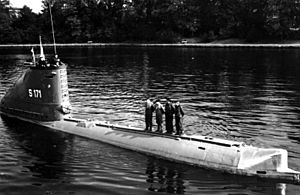German submarine U-2322 facts for kids

Postwar photo of Hecht (S 171), (former Type XXIII submarine U-2367). An identical sister ship of U-2322.
|
|
Quick facts for kids History |
|
|---|---|
| Name | U-2322 |
| Ordered | 20 September 1943 |
| Builder | Deutsche Werft, Hamburg |
| Yard number | 476 |
| Laid down | 22 March 1944 |
| Launched | 30 April 1944 |
| Commissioned | 1 July 1944 |
| Fate |
|
| General characteristics | |
| Class and type | Type XXIII submarine |
| Displacement |
|
| Length | 34.68 m (113 ft 9 in) |
| Beam | 3.02 m (9 ft 11 in) |
| Draft | 3.66 m (12 ft) |
| Propulsion |
|
| Speed |
|
| Range |
|
| Test depth | 180 m (590 ft) |
| Complement | 14–18 |
| Armament |
|
| Service record | |
| Part of: |
|
| Commanders: |
|
| Operations: |
|
| Victories: | 1 merchant ship sunk (1,317 GRT) |
The German submarine U-2322 was a special type of submarine called a Type XXIII U-boat. It was built for Nazi Germany's navy, the Kriegsmarine, in 1944. This submarine was very advanced for its time.
U-2322 was one of only a few submarines of its kind to go on war patrols. It was also one of only three to complete two patrols. During these missions, it successfully sank one British cargo ship. This was one of only five ships ever sunk by this type of submarine.
U-2322 was built quickly in Hamburg, taking only four months. It was ready by July 1944. However, it was a new design, so it wasn't ready for battle until 1945. There were many engineering problems to fix. Also, the crew needed special training to use the new boat and its new battle plans. When it finally went on its first patrol in February 1945, it was more like a test. The goal was to see what the submarine could do, not just to sink enemy ships.
Contents
What Was the U-2322 Like?
Like all Type XXIII U-boats, U-2322 had a certain size and weight. It weighed about 234 tons when it was on the surface of the water. When it was underwater, it weighed about 258 tons.
The submarine was about 34.68 meters (113 feet 9 inches) long. It was about 3.02 meters (9 feet 11 inches) wide. Its depth, or how far it sat in the water, was about 3.66 meters (12 feet).
How Did It Move?
The U-2322 had different engines to help it move. It used a diesel engine for power when it was on the surface. It also had two electric motors for when it was underwater. One electric motor was for normal speed. The other was a special quiet motor for moving very slowly and silently.
How Fast and Far Could It Go?
This submarine could travel at different speeds. On the surface, its top speed was about 9.7 knots (18 km/h or 11 mph). Underwater, it could go faster, reaching about 12.5 knots (23.2 km/h or 14.4 mph).
It could travel a long way without needing to refuel. On the surface, it could go about 2,600 nautical miles (4,800 km or 3,000 mi) at 8 knots. Underwater, it could travel about 194 nautical miles (359 km or 223 mi) at 4 knots. The submarine could dive safely to a depth of about 180 meters (590 feet).
What Weapons Did It Have?
The U-2322 was armed with two torpedo tubes at the front. It could carry two torpedoes ready to fire. Unlike some larger submarines, this type of U-boat did not have a deck gun. The crew on board was usually between 14 and 18 people.
The U-2322's Missions
U-2322 left Horten Naval Base in Norway on February 6, 1945. It headed towards the East coast of Scotland. It patrolled near St Abb's Head. This area was sometimes used by single cargo ships. These ships thought it was too dangerous for German submarines to wait there.
First Successful Attack
This plan worked on February 25. The steam merchant ship Egholm, which weighed 1,317 tons, was sunk by a torpedo. This was the first and only success for U-2322. It happened in the dark near Holy Island. The rest of this first patrol did not result in any more sinkings.
Second Patrol and End of Service
The submarine's second patrol was in April, off East Anglia. This mission was not successful at all. Strong Allied escorts and well-organized convoys made it very hard for the small U-boats to find targets.
A good thing about these patrols was that no Type XXIII boat was lost in the North Sea. Any losses of this type of submarine happened in German waters. These losses were from accidents, bombing raids, or hitting naval mines.
When Germany surrendered, U-2322 was in Stavanger, Norway. From there, it sailed to Loch Ryan in Scotland. It was part of an operation called Operation Deadlight. On November 27, the submarine was towed out to sea. It was old and rusty, and it was destroyed as a target for naval gunnery practice.
Ships Sunk by U-2322
| Date | Ship Name | Nationality | Tonnage (GRT) | Fate |
|---|---|---|---|---|
| 25 February 1945 | Egholm | 1,317 | Sunk |

